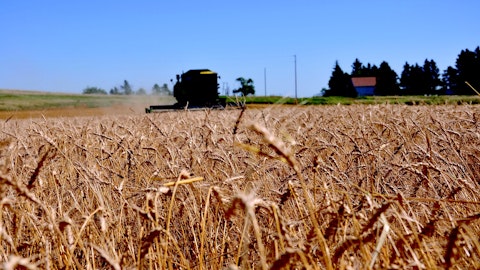This article presents an overview of the 10 most consumed foods in the world. For a detailed overview of the most consumed foods in the world, read our article 25 most consumed foods in the world.
-
Meat, Chicken
Per Capita Consumption (KG): 15.6
Meat, Chicken is a staple protein source worldwide, with leading producing countries including the United States, China, Brazil, and India. It is versatile in various culinary dishes, from fried chicken to stews and sandwiches. In 2021, the value of chicken sales was $14.9 million, which is 20% less than 2020.
-
Cassava
Per Capita Consumption (KG): 15.3
Cassava is a starchy, tuberous crop that is a significant food source for millions in Africa, Asia, and South America. The leading cassava producers are Nigeria, Indonesia, Thailand, and Brazil. Cassava can be eaten fresh but is commonly processed into flour, chips, or tapioca. The cassava market was valued at $175.9 billion in 2022 and is projected to grow to $254.28 billion by 2032, with a 4.18% annual growth rate. This growth is driven by increased demand for cassava starch in the food and beverage industry, greater use of cassava in sweetener production, and its high usage in snacks and cereals.
-
Seafood
Per Capita Consumption (KG): 20.2
People worldwide enjoy seafood for its delicious taste and versatility in various cuisines, from sushi in Japan to shrimp scampi in Italy. It’s a vital source of protein and essential nutrients like Omega-3 fatty acids, known for promoting heart and brain health. Major seafood-producing nations include China, Indonesia, India, Vietnam, and the United States. In 2022, retailers in the United States sold 696 million pounds, 14 million more pounds of fresh seafood than in 2019.
-
Sugar
Per Capita Consumption (KG): 20.4
Brazil, India, Thailand, China, and the United States are the leading sugar-producing countries. Sugar is used in various food products, including candy, baked goods, and soft drinks. It is also used in multiple industrial applications, such as the production of ethanol and biofuels. The industrial sugar market is expected to achieve a value of USD 59.1 billion by 2028, demonstrating growth from its 2023 value of USD 46.4 billion. Notably, sugar prices have experienced a decline in recent years, reaching levels reminiscent of those observed in the mid-2000s.
-
Maize
Per Capita Consumption (KG): 18.2
Maize is a staple food for millions of people. The leading producing countries of maize are the United States, China, Brazil, Mexico, and India. It is a significant source of carbohydrates and calories for human consumption. Maize is used to make various industrial products, such as plastics, adhesives, and cosmetics. In the marketing year of 2022/23, 45 million bushels in maize usage have been reduced.
-
Tomatoes
Per Capita Consumption (KG): 21.2
Tomatoes are a fruit from the nightshade family (Solanaceae), originating in Central and Western South America. The global market value for tomatoes was estimated to be $181.74 billion in 2022 and is projected to reach $273.2 billion by 2031, growing at a compound annual growth rate (CAGR) of 4.635% during the forecast period (2023-2031). In the United States, the total value of fresh and processed tomatoes produced in 2015 was $1.22 billion and $1.39 billion, respectively.
-
Potatoes
Per Capita Consumption (KG): 32.9
The indigenous peoples of the Andes mountains in South America first domesticated potatoes. The Spanish introduced the potato to Europe in the second half of the 16th century. Potatoes are a good source of carbohydrates, dietary fiber, potassium, and vitamin C. They are also low in fat and calories. In 2021, the world produced 101 billion tons of potatoes. They are grown in over 100 countries worldwide.
-
Wheat
Per Capita Consumption (KG): 67
Wheat is grown in over 170 countries and is a staple food for billions of people. China, India, and the European Union are the top three wheat producers. Russia was the top exporter of wheat worth $8.92B in 2021. In 2022, China yielded wheat at 23,568 hectares and produced about 136.9 million tons.
-
Rice
Per Capita Consumption (KG): 78.4
Rice, a staple crop, is cultivated across 158 million hectares yearly. It holds a unique position in the developing world, with its production value twice that of any other food crop. Rice serves as a fundamental food source in numerous Asian markets. The prices of rice play a significant role in determining food price inflation and food security, especially for the most economically disadvantaged households. The average price of rice is $17.30 per hundredweight (cwt), projected to decrease to $14.50 per cwt in 2024 slightly. It is anticipated that rice prices will continue to hover around their current elevated levels until 2024.
-
Milk
Per Capita Consumption (KG): 79.3
India, the United States, China, Pakistan, and Brazil are the top 5 milk-producing countries in the world. Over the past thirty years, global milk production has grown substantially, surging by over 59%. In 1988 the world produced 530 million tons of milk, which escalated to 843 million tons by 2018. In the subsequent year, 2019, global milk production reached 881 million tons. Additionally, on an individual basis, per capita consumption of dairy products increased to 114.7 kilograms in 2019, marking a 1.2% uptick. The dairy industry carries significant economic importance in the United States, contributing $49 billion in direct economic impact.
Insider Monkey focuses on uncovering the best investment ideas of hedge funds and insiders. Please subscribe to our free daily e-newsletter to get the latest investment ideas from hedge funds’ investor letters by entering your email address below. You can also take a look at the 20 Most Addictive Foods According to Science and the 16 Most Popular Breakfast Foods in America.





